#roadmap template
Explore tagged Tumblr posts
Text
How To Create An SEO Roadmap That Actually Drives Results
Discover how to create an effective SEO roadmap that drives real results. Learn step-by-step strategies, key components, tools, and expert tips to build your organic visibility. How To Create An SEO Roadmap That Actually Drives Results Creating an effective SEO roadmap isn’t just about choosing a few keywords and building backlinks. It’s a strategic process that aligns your business goals with…
#content strategy#how to create SEO roadmap#keyword research#link building#on-page SEO#SEO checklist#SEO goals#SEO plan#SEO roadmap#SEO roadmap template#SEO strategy#technical SEO
0 notes
Text
0 notes
Text

Please don't forget to fill in the survey, fellas!
As consumers — and as people who care about the longevity of this game — it is vital that we make ourselves heard whenever possible. And surveys like this one is one of the best ways of voicing our concerns and/or complaints.
(For anyone looking for a template, @/simp4liferz on Twitter has one that you are free to use and build upon as you wish)
Below are the requests I plan to put in my own survey, for anyone interested:
1. Release the rest of Sylus' standard content, increase his affinity cap, and update his orbits.
2. Give us roadmaps for future updates/additions to the game
3. Add more permanent ways to farm Diamonds and other resources.
-As currently is, it is incredibly difficult for end-gamers and F2Players to earn Diamonds outside of dailies and SHC, the latter of which requires a high number of high level 5 stars and protocores, and a variety of stellactrums. For Sylus mains, Caleb mains, low spenders, and F2Players it is near impossible to adequately meet these requirements.
4. Increase event rewards.
5. Increase droprates for bounty hunts.
6. Increase the rewards for awakening memories.
7. Lower the mats needed to level up memories.
8. We need better and clearer communication from the company.
- the total lack of response or communication from the company regarding the concerns we — your consumers — have repeatedly brought up through emails and social media during these last couple of months has been incredibly disheartening and disappointing. As customers, we deserve the bare minimum of communication from you. The lack of it causes uncertainty, as well as in some cases the spread of rumors and misinformation.
9. Add more regular updates to the main story.
10. Add more permanent and substantial features to the game, such as additional playtime minigames or new battle modes
11. Announce new banners at least a week before they are released so that every player has a chance to somewhat prepare for them.
12. Release reruns of past banners, particularly solar myths.
13. Fix the lighting for low light kindled scenes. At present, the lightning issues in said scenes make it difficult to see MCs with darker skin tones in them. We want this game to be equally inclusive for every player
14. Do not separate the outfits and hair/cosmetics in limited banners. Put them all in the same crate.
15. Do not put event outfits or hairstyles/cosmetics behind paywalls.
16. Do not put any of MCs non-combat outfits behind paywalls.
17. Make curly hair for MC an option in cutscenes and etc. Not just in glint photobooth.
18. Allow us the option to hear MCs voice during kindleds and Tender Moments.
19. Slow down the speed of MCs subtitles. They go by so fast that they are impossible to read without pausing the game and using the dialogue log, which breaks the immersion.
20. Sell LADS merch globally.
21. (during battle) Don't start the timer until the player has reached the checkpoint.
22. Release at least one 4 star with an illustration of Sylus and MC together. Every other LI has at least one each with MC. Fair treatment amongst all 5 LIs is important
#justice for sylus#and lads as a whole#lads#love and deepspace#sylus#lads sylus#love and deepspace sylus#sylus lads#sylus love and deepspace#lads zayne#lads rafayel#lads xavier#lads caleb
119 notes
·
View notes
Text
Stuck in Planning Stage of Writing
Anonymous asked: Do you have any advice on how to get out of the planning stage and more into the doing stage of writing? I’m up to my ears in notes for scenes and fragments of dialogue between characters. I know where I want to go with the story, I’ve even written a handful of scenes when the ideas come to me, but now that I have this lump of thoughts I need to start organizing and placing them all in their rightful spaces. The one thing I truly know is how much I’d love to see this through. Do you have any advice for a girl who’s unwittingly made herself stuck with a puzzle?
[Ask edited for length]
Planning a novel can sometimes be like digging a really deep hole for a specific purpose, then suddenly realizing you've stranded yourself at the bottom of the hole without a ladder. You've spent so much time digging the hole, you'd like nothing more than to get out of the hole and move forward with whatever project required you to dig the hole in the first place. There's just one problem: you can't teleport yourself out of the hole. You have to climb... or, ideally, build yourself a ladder to climb out with whatever materials are available to you.
That's probably where you are right now with your story. The hole you've dug was necessary, and it's good that you dug it, but as much as you'd like to just magically leap out and write your story, you can't do that. You have to build yourself a ladder to climb out of the hole first. So...
My go-to emergency "get out of the planning hole I've dug myself into" ladders are timelines, scene lists, and outlines.
Timelines: Your story may take place over a single day or several centuries, but either way, time flows in your story. All of those notes and fragments of dialogue and partial scenes are moments or events that happen within the time frame of your story. So, plotting those moments and scenes out on a timeline--according to when they need to happen--is about the easiest way to break your story down into its existing pieces and to see what's missing/where.
There are lots of ways you can format a timeline, such as a table, a list, a horizontal timeline, calendar, or a roadmap timeline. My go-to is a basic two-column document where the left column is date/time and the right column is the moment/event. There are also apps and online tools that will help you build a timeline in various formats.
Horizontal Timeline:

Calendar Timeline:
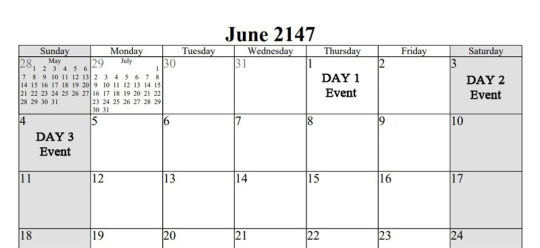
Table Timeline:

More info: Making a Timeline for Your Story Scene Lists: Stories are made up of scenes, so a list of those scenes is another great way to organize the events of your story. You may even find that creating a scene list is easier after making a timeline, because a timeline may help you see where certain moments or events need to be their own scenes and which can be combined together into a single scene. Just like timelines, scene lists can be as simple or complex as you want to make them. Once again, my go-to is a simple two-column document with the left column for the scene number and the right column for the scene summary, preferably just a sentence or two. Ultimately, once I have my rough timeline and scene list done, I usually combine them into one multi-column document along with my story structure beats.
Table Scene List with Beats:

Complex Scene List/Timeline/Beat Sheet:
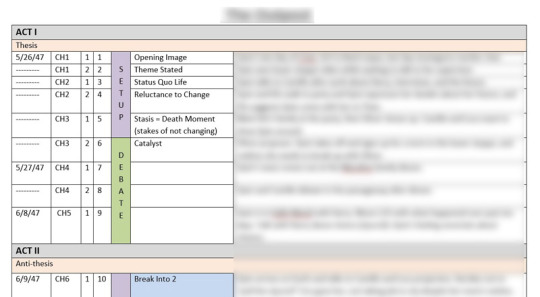
More info: Scene Lists
Outlines: Outlines can be really any format you want them to be, and some people count timelines and scene lists as their outlines. My go-to outline is just an exhaustive beginning to end summary of everything that needs to happen. Sometimes, just working through your story from beginning to end can be the best way to make sense of all those disparate pieces you've been piling up.
More info: Guide: How to Outline a Plot Story Structure: Finally, I want to talk a bit about story structure templates like Save the Cat Writes a Novel!, Larry Brooks story structure, seven point story structure, etc. Story structure templates can be a really great way to make sure you're hitting all the right story beats--almost like a road map through your story. It's just important to know you do not by any means have to stick to any particular story structure exactly. Use it as a guide, take what works, leave what doesn't, and don't panic if your beats don't fall exactly where it says they should. As long as your story is working, that's what matters. Some writers even like to frankenplan their stories using a variety of different structure templates.
More info: Creating a Detailed Story Outline (story structure)
Once you finally have a roadmap for moving forward, whether that's a timeline, scene list, outline, or all of the above, you know you're ready to start writing!
Final note: I just want to add that planning isn't for everyone. Some people are discovery writers who let their stories work themselves out as they go. The above is just meant for people who are planners, who have done a lot of planning, but need to pull that planning together into a cohesive, organized document. And... if you have all of the above and still find yourself unable to start, you might find help in the links below. Happy writing! More help:
Beginning a New Story Figuring Out Where to Start a Story Deciding How to Open Your Book How to Move a Story Forward Trouble Getting Started Have Plot, Can’t Write
•••••••••••••••••••••••••••••••••
I’ve been writing seriously for over 30 years and love to share what I’ve learned. Have a writing question? My inbox is always open!
LEARN MORE about WQA
SEE MY ask policies
VISIT MY Master List of Top Posts
COFFEE & FEEDBACK COMMISSIONS ko-fi.com/wqa
310 notes
·
View notes
Text
FREE! - Weekly Reset Notion Template 🌿

Introducing Weekly Reset — a one page Notion Template designed to help you take control of your weekly routine by combining goal setting, task management, and personal reflection.
Imagine ending each week with a sense of accomplishment and beginning each new one with clear intentions. The Weekly Reset Notion Template is your go-to guide to break down weekly goals, prioritize tasks, and reflect on your journey.
Start each week with a roadmap, prioritize what’s essential, and look back to celebrate wins and learn from every experience. It’s the perfect way to turn each week into a productive, intentional journey.
What's Inside?
Weekly Tasks — Start each week by defining all the tasks you want to tackle
Weekly Priority — Clarify your top priorities to stay focused on what’s most important
Weekly Agenda — Map out your week in advance, giving you a high-level view of your commitments, goals, and special reminders
Reminders — Keep you remind of the little essential things
Daily Schedule — Never lose sight of the big picture of your goals while keep progressing
Reflection Journal — Wrap up each week by diving into what went well, lessons learned, and areas for growth. This journal space lets you reflect on wins, challenges, and insights so that each week builds on the last
Dark and Light Mode available!
Get it now for free! ⬇️
#notion#notion template#notion inspo#notion aesthetic#notion dashboard#notion setup#notion tutorial#notion.so#productivity#planner#digital planner#studyblr#studyspo#study blog#study aesthetic#study space#studying#bullet journal#journaling#digital journal#university#it girl#bookblr#cinnamon girl#coquette#girlblogging#pink core#girlblogger#light academia#aesthetic
78 notes
·
View notes
Text

De Zomer van Vertalingen
Hoi allemaal,
Welcome to my summer project~!
What's that about?
De Zomer van Vertalingen is a summer-long project all about translations (literally The Summer of Translations), during which I intend to release translations of my games - specifically in Dutch.
From June through August, I will be uploading each week either an update of a previously released short game to include the new translation(s*) OR release a new short game that will include a Dutch translation (Neo-Twinies!) OR (and that's if I'm really confident) create a short story starting with Dutch first before translating it in English/French**. *Yes so... there are a couple of games written in French or English only. In that case, it's a double translation: Dutch + French/English (which ever is missing). **because I know Dutch as such little reach compared to those two languages...
What's that for?
My main reason is that I need to improve my Dutch for personal reasons asap, and this was the best way I could think of when it came to writing skills. I get to learn new words, practice my sentence structures, and maybe have some half-decent writing to show off in the future.
Another big one is that... I've been in a big funk since pretty much last summer. I think you've probably all noticed that, aside for a random game or template update, I've been pretty quiet on that front*. It's been a stressful and difficult period, and it's affected my creativity and motivation to write**. None of my usual tricks have been working so far, and this is pretty much my last resort to jump-start it all. *even about Svipul and a mini French parser. It's been out, under the radar. I legit don't remember making those. *or even code... see Harcourt being 6 months late...
A couple of other reasons: I've found some typos and small issues that need to be corrected; I am in the process of archiving games/releasing source codes (related to previous); There're actually really few IF games in Dutch (IFDB/itch.io); A few of my games need a QoL update or two; Hoping to find some inspiration from revisiting older works; Shamelessly doing a little bit of promotion for myself too; And... why not for the fun of it?
What to expect?
As I said above, weekly (re)release of a short game.
Short games (as in under 1000 words), because translating long games seems neverending* and I don't want to quit before I even start; but most importantly MelS is my guinea-pig the kind soul who'll go through that mess and there's only so much I can put him through**... So, that means games like Collision or Dévoiement or Intersigne will definitely appear on the list. *I've done that for Meeting the Parents, DOL-OS and Les lettres du Docteur Jeangille, and I wanted to pull my hair out. **and also I'm asking a lot of his free time...
And new works too. The Neo-Twiny Jam (@neointeractives) and the Nouvim3000 (French) are just around the corner, and I already got a couple of ideas to play with (some planned for previous jams, but never completed). So, I'm hoping for one or two to come out*. *at least one for NTJ, since it's for a good cause.
Maybe (that's that's a big asterisk maybe) I manage the impossible and writing something in Dutch from scratch.
So that will be (hopefully) 13 releases throughout the summer.
As per my planning (because, yes, I've done some), I have about 10-or-so short games which can be easily (heh) translated/fixed. That gives me 3 slots to fit at least the Neo-Twiny and the Nouvim, maybe even the Single Choice Jam.
And then, what?
Back to regular programming, dusting off my WIPs and actually complete them. For real this time. Like actually not putting them off anymore. I even have a Roadmap for it. Probably finishing Exquisite Cadaver first since it's completely mapped out and the smallest.
And then, we'll see :)
#de zomer van vertalingen#the summer of translations#translation#english#français#nederlands#interactive fiction#interactive games
16 notes
·
View notes
Text
0 notes
Note
So! I was planning on writing a Batman fan fic and had a question about the urban facing side I was wondering if you could help on. I suppose this can intersect with other super hero / billionaire figures. Interested in exploring urban development in the setting but trying to avoid pitfalls , but ofc no worries if this isn’t something in your purview or interest
I feel like Gotham, so deeply realized as a fictional setting and riddled with its issues as a city, would be a great template to explore these urbanist issues. And while Batman treats symptoms - protecting people from acts of violence, and also pursuing those who are responsible for the corrupt systems who have put themselves above conventional pursuit. But Bruce Wayne I feel like by a lot of fans can he overlooked as an agent of improvement in Gotham - he can use his political and economic clout to both publically and privately improve the systemic conditions of the city, like his famous hiring program for ex cons. And I would like to explore this side a lot deeper, however I’m wary of showing a billionaire as the only solution , or even the best solution to a city’s issues and basically recreating public policies privately.
Since showing a privatized solution to be the answer to all these problems isn’t the sentiment I want to give, as often private corporations are the ones exploiting / building up this cult of personality around millionaires is already troublesome. But ofc, Bruce Wayne is fictional and can be an example of how a CEO ought to act, but would like to show these solutions are achievable and to be sought after in the public sphere - we shouldn’t expect CEO to hire ex cons, build free transit, eliminate all these zoning issues by buying half the city because 1) unrealistic and 2) can institute a dangerous mindset where it’s like “just give everything to billionaires and they’ll fix things!” (See, the cult of musk)
So my question is, do you have any recomendations on how to achieve this balance of using Wayne as a championing workers rights, urban development , reform etc. without just shilling for billionaires? Because, after all, billionaires have been opponents and don’t want to diminish that. Perhaps using his influence to give away his infouence to others , if that makes sense. or even better - historical examples of figures of privilege utilizing their position to advocate for the public sector and go all in as earnest urban Allies as a roadmap to model this after?
This is a really interesting question, and I think points to some of the limitations of what can be done with the Bruce Wayne archetype.
As I've said before, I think what can be done to make Wayne an enlightened person without falling prey to the mentality that "the billionaires will save us!" (looking at you, RALPH) is to really explore the limitations of top-down reform.
Because if there is one genuine weaknesses both to the Batman and Bruce Wayne, it's that he has a well, "heroic" mindset in which he thinks that if he's just smart enough, prepared enough, tough enough, that he can win a one-man-war on crime and other social evils - but you don't really see him engaging in movement-building in either his vigilante or civilian sides.
In the former, even if we leave aside his more "lone wolf" depictions, Batman has issues with trust and working well in groups. At best, he cultivates a small number of people (the Robins, the JLA), and he tends to keep people at arm's length. In the latter, even when Bruce is trying to make systemic, social interventions in transportation or housing or health care or social welfare, it's usually done through a top-down approach - build this project here, support this politician there - rather than sitting down and doing an analysis of how he could build a sustainable majority coalition with the muscle to change Gotham on its own.
Realistically, an honest, militant, and strategic Waynetech union (albeit assisted from the shadows to keep the mob and the supervillain gangs at bay) could do more to change Gotham for good than any Foundation that has ever or could ever exist.
35 notes
·
View notes
Text
Productivity Starts with Planning 📝🌱 | a simple guide to get started

Let’s be real—one of the biggest obstacles to productivity is not knowing where to start. We all have long to-do lists, meetings, goals, and side projects constantly competing for our attention. Without a clear plan, it’s easy to feel scattered and overwhelmed. That’s why, if you want to truly get things done, planning is your secret weapon. It doesn’t just organize your day, it gives you a roadmap to success.
Here’s a simple guide to get you started:
1️⃣ Create a New Page for Your Planner Start by creating a new page in Notion. You can name it something like “Get Things Done” or “Productivity Hub”—whatever resonates with you. This will be your dedicated space for organizing all your tasks, goals, and priorities.
2️⃣ List Down Goals of the Day Start your day by writing down 2-3 key goals you *must* achieve today. These should be tasks that move you forward, whether it's work-related or personal. Listing them helps you stay focused and gives you a clear direction.
3️⃣ Prioritize Your Tasks At the start of each week, list out your tasks and decide which are the most important. Prioritize based on deadlines, impact, and urgency to ensure you’re focusing on the right things.
4️⃣ Time-Block Your Day Time-blocking is a game changer for productivity. Create a simple table or list that breaks down your day into time blocks (e.g., 9 AM–10 AM: Emails, 10 AM–11 AM: Project work).
5️⃣ Create a Productivity Journal A productivity journal helps you track your progress, reflect on daily wins, and identify areas for improvement.
Transfer your daily goals into the productivity journal’s database. With all your goals and progress in one place, you’ll have a clear record of your achievements, helping you stay organized and motivated as you track your everyday productivity.
At the end of the day, productivity isn’t about doing more, it’s about doing what’s important, better. Let’s turn your chaotic days into productive ones with the right plan—and the right Notion template, you can start planning with Get Things Done (GTD) Notion Template for FREE on Gumroad and Ko-fi, click the link below! 💼✨
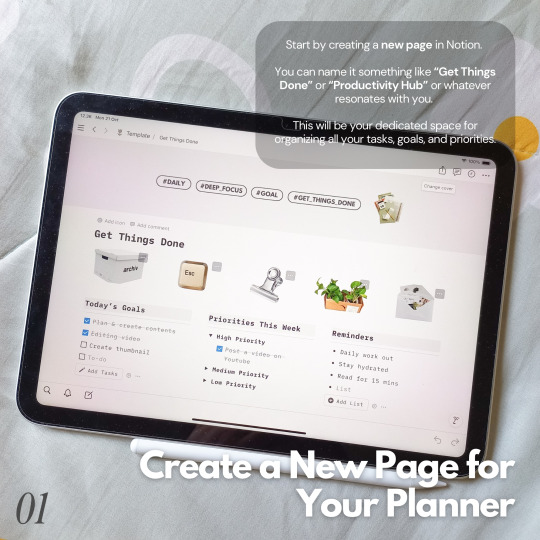
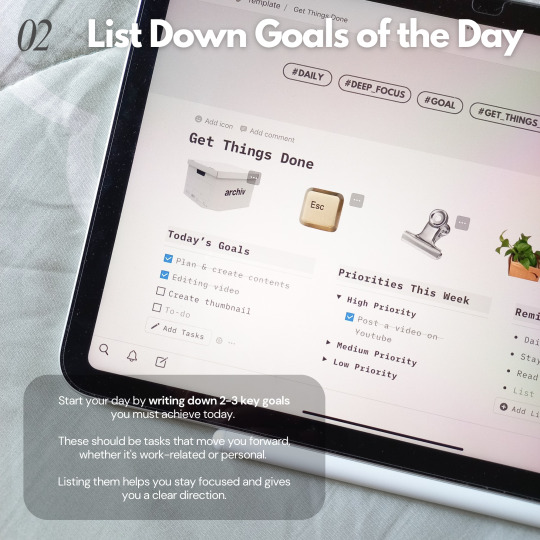

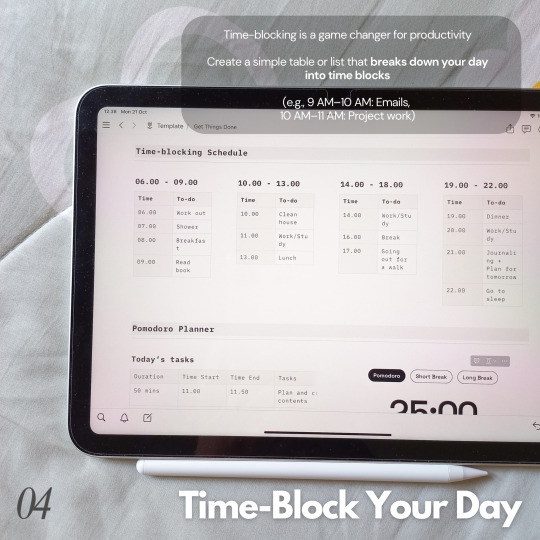
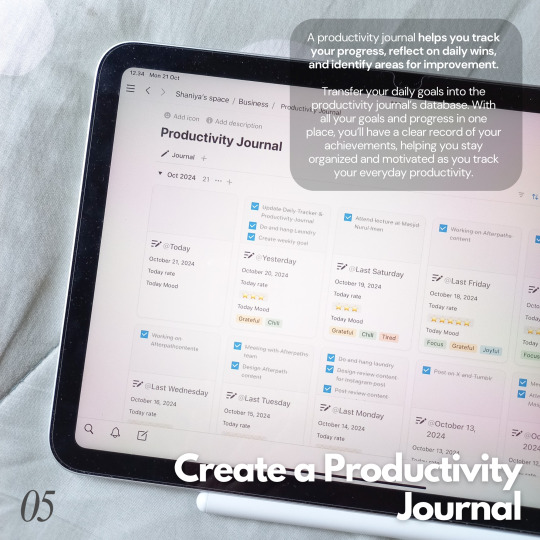

#notion#notion template#notion inspo#notion aesthetic#notion dashboard#notion setup#notion tutorial#notion.so#productivity#planner#digital planner#miffy#studyblr#studyspo#study blog#study aesthetic#study space#studying#bullet journal#journaling#digital journal#university#it girl#bookblr#girlblogging#minimalplanner
18 notes
·
View notes
Text
0 notes
Text
Trope chats: Hero's journey

The Hero's Journey, a narrative structure first articulated by Joseph Campbell, has left an indelible mark on literature, becoming a fundamental template for countless stories across cultures and epochs. This essay explores the use of the Hero's Journey, its pitfalls, evolution, and its enduring appeal, shedding light on its profound impact on storytelling.
The Hero's Journey is a monomyth, a universal template found in myths, legends, and epic tales across diverse cultures. It typically consists of stages such as the Call to Adventure, Crossing the Threshold, Tests and Trials, the Abyss, Transformation, Atonement, and the Return. Protagonists embark on a transformative journey, facing challenges, meeting mentors, and ultimately emerging changed, having attained wisdom or growth.
The Hero's Journey serves as a scaffolding for many literary works, providing a reliable and relatable structure that resonates with audiences. Iconic characters like Frodo Baggins in "The Lord of the Rings" and Luke Skywalker in "Star Wars" follow the Hero's Journey, creating an accessible and familiar narrative arc. This structure helps writers create compelling stories that tap into universal themes of struggle, self-discovery, and triumph.
While the Hero's Journey offers a powerful storytelling tool, its formulaic application can lead to predictability and cliché. When writers adhere too closely to the prescribed stages, narratives may become formulaic and lose their freshness. Additionally, the structure may not suit every story or genre, risking a lack of innovation and diversity in narrative approaches.
The Hero's Journey has evolved over time, adapting to cultural shifts and reflecting changing perspectives on heroism. Modern reinterpretations, such as anti-heroes or flawed protagonists, challenge the traditional mold. The evolution also extends to the diversification of heroes, with stories featuring protagonists from various backgrounds, genders, and perspectives, broadening the narrative landscape.
The enduring appeal of the Hero's Journey lies in its ability to resonate with the human experience. Audiences connect with protagonists facing challenges, overcoming adversity, and undergoing personal growth. The journey mirrors life's struggles and triumphs, providing a narrative framework that speaks to the universal desire for self-discovery and transformation. The familiarity of the Hero's Journey contributes to its timeless allure, offering a narrative roadmap that resonates across cultures and generations.
The Hero's Journey stands as a testament to the power of archetypal storytelling. Its widespread use in literature underscores its ability to capture the essence of the human experience. While the pitfalls of formulaic application exist, the evolution of the Hero's Journey showcases its adaptability and enduring relevance. As storytellers continue to innovate and explore new narrative territories, the Hero's Journey remains a steadfast companion on the literary odyssey, inviting audiences to embark on transformative adventures across the vast landscape of human imagination.
#writeblr#writers of tumblr#writing#bookish#booklr#creative writing#fantasy books#book blog#ya fantasy books#ya books#writing community#teen writer#writing blog#writers#tumblr writers#writblr#writer problems#writerblr#writers community#writers corner#writers on tumblr#writerscommunity#writerslife#new books#book quotes#book#book review#books#book recommendations#booklovers
11 notes
·
View notes
Note
Hi I'm the person who asked for education advice.
I would like advice on almost everything you mentioned, the learning aspect itself and breaking down goals mostly. Also just the fear of failure haunts me a lot. Also, you're in your 20s right? Do you live alone, on campus, with parents? Is that hard to adjust to, if you know about that? I really appreciate you answering asks and giving advice on things not related to Naruto specifically haha. Love your art! Can't wait for the chaptered manga you're making 💜
Hi! This took me a while as I was stressing over some things, sorry about that, and yes! Well, I live alone currently and am renting an apartment. It is not hard to adjust to for me personally because I used to live in a house that was empty since I was… well let's just say I’m used to it, but when I traveled and studied/worked abroad I did live with other people which I thought was more difficult to adjust to. All of a sudden there’s so much noise and drama aaahhh >< hehe.
I hope my tips are helpful for you— long post, read when you have time and grab your notes! 」( ̄▽ ̄」)
.📙⤵
Small note: this system may seem like a lot of work or tedious for majority of people, but setting it up like this is the only thing that works for me and aids my struggle to focus. This post focuses on studying, but I apply this to a lot of other areas as well. I’m still readjusting parts where I feel like it can improve— of course, you can change anything in any way you like! I tried to make it as clear as possible ^^!
My documentation style: I personally use Notion (almost a year now) to track everything while documenting and organizing my notes. I love how you can create the most aesthetic pages and build your space anyway you like. It helps me structure my life so much better than the note-taking systems I used to have. I'm not kidding when I say it really changed everything for me. For studying, but also other area's, which is why I affiliated with them. There are paid subscriptions, but everything you need you can use for free!

I also have template recommendations if someone does happen to use Notion! (Let me know if you're looking for anything specific!) However, of course you can use whatever program you want to document things/your study. Whatever you use, even if you just write it down on paper, I do recommend keeping it all in the same place by creating a singular overview so you can track your progress more easily, but we’ll get to that later!
My roadmap to achieve (academic) goals:
Goal Setting
I think the most important thing is to set effective goals that are clear. Proper planning is essential to reaching goals and achieving good grades imo, as well as breaking down your tasks into manageable chunks to avoid feeling overwhelmed. It’s learning how you work, what fits your productivity-style and finding ways to make it easier for yourself.
So take a moment to think what exactly you want to achieve!
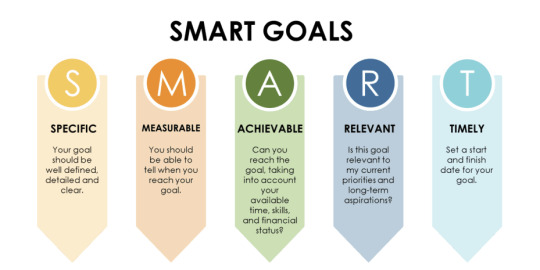
You can use the SMART-method (setting Specific, Measurable, Achievable, Relevant, and Time-bound goals), to give yourself clear targets to work towards and there are many articles on it if you want to know more about it (you can also look for helpful templates, there are many free ones you can find!), but I combined this with "The 12 Week Year”-method by Brian P. Moran and Michael Lennington.

(Although I would recommend this book, there’s quite a bit of fluff which will probably make it difficult to get through for people that are neurodivergent. If you’re interested you can also find summaries on Youtube in order to only gain the information you need if you want to use it to achieve goals, but I’ll break it down here as well. Summaries are incredibly helpful, but I’ll be honest and say I’m not sure how to feel about them yet.)
The 12 week year describes lag and leading indicators in the context of goal achievement. I use these indicators specifically in order to make sure I can Measure my goals.
I’ll explain with examples:
Regarding your previous ask, let’s take a goal like “getting high grades”. This doesn’t say much yet.
There are probably several subjects you want a high grade for, so let’s break that down first. There are many smaller goals that exist in that. It’ll look something like this:
Overarching goal: Getting high grades
Individual goals:
Getting a high grade for subject A
Getting a high grade for subject B
Getting a high grade for subject C
Etc,—
Great start in getting clear what you need to achieve, but it’s still too vague, right? Let’s see these subjects as separate goals and break it down further with indicators:
Indicators:
Lag indicators are the ultimate measures of success or results necessary to achieve your goals. They represent the outcomes.
Leading indicators are the actions or behaviors that directly influence the achievement of lag indicators. They are individual tasks and the steps that you take to achieve the lag indicator.
Note: Indicators must start with a verb (like: write, get, draw, finish, etc—) because it indicates directly what the action is you have to take. Example: “Assignment” doesn’t tell you what to do. Transform it into “Finish assignment on [x] before 16th of May” or something like that. It depends on the goal.
Now we get something like this:
(Overarching goal: Getting high grades) Individual goal: Getting a high grade for subject A
Lag indicators examples (what’s necessary to achieve the goal):
Write Essay on [x]
Finish assignment A
Setup project A
Start project A
Etc,—
It’ll look different per subject and it may look different for you. Maybe you know exactly what you need to achieve per period or maybe they only let you know what needs to be done one assignment at a time, in which case you can focus on that alone and take it step by step.
It’s already nice to just write everything down and gain a clearer view of the things you need to complete. You’re not pressured to remember anything, because it's all here (I get stressed forgetting stuff).
Now you have your overarching goal of wanting to get high grades and made a list of individual goals. We’ll consider these individual goals and focus on them because achieving those means your overarching goal will be achieved automatically.
If you gathered the lag indicators for these individual goals, you’ll now know what (currently) is necessary to get a high grade for subject A and we can start breaking those down into leading indicators.
It’ll look like this:
(Overarching goal: Getting high grades) (Individual goal: Getting a high grade for subject A) Lag indicator: Write Essay on [x]
Leading indicator examples (steps you take to achieve the lag indicator):
Understand exactly what the topic or thesis statement is
Research topic
Organize, etc—
Write everything you are going to do in order to ‘write the essay on [x]’ as leading indicators.
Reminder: as the SMART-method suggests: make everything as specific as possible so you can measure exactly what it is you need to do. Example: “Research topic” can still be too vague but you can clarify what you need to research for what topic, once you understand what it is exactly you need to do.
Putting in a little bit of effort and time now by breaking down goals like this helps me save a lot of time later, because I have to make less decisions and I’ll exactly know what to do and how much. Tracking your progress makes it a lot easier if you know what you’re tracking and as I said before: decision fatigue is a real thing and emotionally taxing! Making all the decisions before you start working really can help!
Tip: before starting on the leading indicators, check whether your goals and its lag indicators are SMART. Make sure all of them start with a verb! Tip 2: if you have trouble deciding where to start, you can refer to the ‘Swiss Cheese’ method which is a productivity “hack” that can help you identify which of your tasks takes the priority. This doesn’t help me personally, because if I planned out what I need to do that day it doesn’t really matter for me which has the priority because I have to rely on many other things, therefore I can’t plan what I do first. I feel like mentioning it anyway, because it can be helpful when making mindmaps.
So in short:
Determine your overarching goal.
Write down individual goals necessary in order to achieve the overarching goal.
Write down the lag indicators you need to complete in order to achieve your individual goal.
Break down the lag indicators into manageable tasks (leading indicators) and be specific on the action you need to take. (Example: don’t just put ‘writing the essay’, but ‘write [x]-essay for 20 minutes’.)
Now we can start planning!
Planning
Let’s say you have a week to finish this essay, once you have every leading indicator, you can start planning out what you will do on which day.
Efficient planning helps reduce stress, because you don’t have to wonder if what you’ll do today is enough. We’ll get to ‘tracking’ goals later, but stay open to readjust when necessary though! It is okay to re-plan because there’s always the possibility of something coming in between or you not feeling well!
As I said before, I use Notion to document everything and I have a separate page for the overarching goals which include my lag indicators, but in my overview I created a table that shows all the tasks (leading indicators) that I need to finish per (current) week. It sort of looks like this:

I automated it, so when I check off something the amount of times I need to do it (under frequency) that week, it disappears from my overview and I can quickly see my weekly (and overall) progress in percentages, but of course you can do this any way you like or just write it down somewhere. I think this way is great because I need less focus to see whether something's already done or not.
I know that sounds funny for people who don't have trouble with this, but genuinely anything I can do to make it easier for myself is helpful ><
We still need to keep deadlines in mind. I personally like to know what I need to do on which day within the week as well or I’ll end up having to do everything during the weekend. So, I divide these weekly tasks and assign a day to them on a simple weekly notepad I keep on my desk. It looks something like this:

These days aren’t set, as I mentioned: it’s also important to allow life to happen and still stay on track somewhat :’)
When I finish something I color it!
So in short:
Once you gained insight on your leading indicators, you can start planning. This will look different for every subject, but the method stays the same.
Create a weekly planning/overview somewhere depending on your deadline. And if necessary, divide the weekly tasks for specific days if you want on a separate planner.
Review your week on Sundays (or whichever day you like!) to see whether you’re still on track and readjust your planning for the upcoming week(s) when necessary.
Combine Studying with your personal life
The reason why I use a written, separate, weekly overview is because I combine areas of my life on here.
Aside from dividing tasks for my study (the leading indicators) for specific dates, I add appointments that I may have (which I keep in my calendar app), projects, administration/financial-tasks or random things I need to do at home or for myself/others.
I know a lot of people that create to-do lists have trouble with it. If that’s you (me too), then we’ll take it a step further and plan our tomorrow every day.
I use simple note-paper and sort of write things down in order for that day, because it’s easy and quick to grab and scribble on. This really helps to focus on what matters right now. It looks like this:

This is sort of like compounding habits, but with tasks. Some things are much easier to do after one thing than another. A regular to-do list may not work because it doesn’t take into account the rest of your day like appointments or a personal routine you want to work on. It’s hard to gain clarity when all you see is a bunch of intertwined, random tasks— so here you’d organize them bit and add whatever is relevant. Like a little mini-planning for the day.
On here I also write small silly stuff I have to do that day or keep notes I have to put somewhere else so I won’t forget. (Like appointments I suddenly get, or e-mails I have to reply to, something I want to check later, etc—)
Tip: Let’s say after a while you still have trouble with this daily mini-planner, you can also just write down (3 or so) your most important tasks for the day and “eat the frog”. You focus on that first while ‘hiding’ all the ones that may not be as relevant immediately. (I’d still keep the other mini-planner though or transform your other tasks into “bonus-tasks”.)
So in short:
Keep appointments in mind or days when you’ll be busy/outside when planning study tasks on specific days. Add the most important or time-consuming tasks first so you gain a clearer view how much time you have for the weekly study tasks.
Use this weekly planner to divide tasks throughout the week and then make a mini-planner for your specific day on a separate paper/document to organize the day.
Keeping track
As I said during the planning-step, you can use Sundays (or other days) to quickly review your week and adjust the next if necessary.
A lot within my system is automated, but even if you’ve written it all down, it shouldn’t take too much time (maybe 10 mins, probably less), because you’ve done most of the planning already. You can easily see what and where it needs adjusting.
Be prepared to adjust a lot in the beginning though if you’ve never done this! Eventually it gets easier and you gain better insight how long you work on something or what is realistic for you to do in a day, which is totally fine!!
Tip: If you are more interested in self-development, you can also apply a review-session monthly, quarterly or per project to gain insight on yourself and where you’d like to improve. I personally do this quarterly, but let’s keep focussing on the study~! Tip 2: If you aren’t sure how to create an overview, there are also many, free SMART-method templates you can use. If you’re usually more a visual person, I’d recommend creating visual boards or just add images to make it more appealing. It may seem like it doesn’t do anything, but especially in this current world of distraction, images do help you connect information much easier and can influence how you feel even subconsciously. I do highly recommend doing so. (I personally use a theme per quarter/season >< it’s so extra lmao it’s a good thing I live alone let’s be honest because I'm embarrassing.)
Studying & taking notes
Well this is a broad subject but I’d recommend sort of observing yourself for a while to really understand more specifically what it is you struggle with. (If you are.)
Here are some examples for ways you can use notes. I used the ‘Second Brain’ method for a while as well, but I’m most comfortable with the Cornell method. I set it up like this:
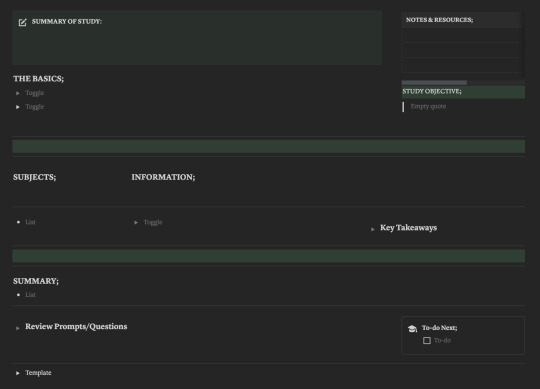
But the most important part here, is this:

I can clearly see the subjects and the necessary information. (I usually hide them under some toggle text to keep things organized and not muddy up my overview.)
Study cards don’t really work for me, because I need to connect information together, but it’s worth looking into! It might be helpful for you.
Tip: If you have trouble focussing because you get bored easily which makes you tired so you seek a quick dopamine rush even if that means you start cleaning your entire environment and you procrastinate, etc—… trust me you’re not alone. I do recommend researching whether a ‘dopamine detox’ will be helpful for you (which is not easy, I’ll tell you that). However, this may not work for everyone because sometimes there’s even more at play. That’s why a combination of strategies to make the actual act of studying as easy and clear as possible, is so important. Tip 2: Always allow yourself to experiment with your routines and keep your health in mind, but if you continue to struggle, please do seek support. Tip 3: If you’re like me and you had to watch/listen to a lot of material, find transcripts or use subtitles! If you have to write an essay on a movie, it’s much easier to get back to information when it’s written down. (And it saves you so much time...) For many movies you can find subtitle files and you can convert them online to remove timestamps if necessary. Tip 4: Ah, and for my fellow neurodivergent people… if noise annoys you and music doesn’t really help anymore, not even when it’s just instrumentals… see if ambient video’s that have slight random background noises (like a library for example) are helpful for you. For me personally, it’s such a game-changer holy sh-
Fear of Failure
Not sure if I can give you some advice on this, because I struggle with this as well. It gets a bit better though when I use this system because it lays down the groundwork for you and with that clarity it gets easier to focus on the task itself. Unless you plan it all out and then end up not doing what you set out to do, and you don’t readjust your planning weekly— it’s sort of hard to fail the action-taking-part.
If it gets really bad and you end up avoiding your tasks entirely, because you get reluctant to take the risk of failing at something, sit down with yourself for a moment and think whether you may’ve set extremely high standards for yourself. See if you can allow a bit more room in your schedule. Refer back to the Goal Setting methods.
Tip: If you’re interested in making it a habit to study, I’d recommend you read ‘atomic habits’ by James Clear, or find a video that breaks the method down for you if that’s easier.
Know that whatever it is you want to improve in, there are ways to do it. If you feel like you get stuck on an area of your life, most of the time focussing on it with frustration will make it worse. Keep your ears and mind open for solutions while taking a break.
I don’t think I’ve ever been anywhere, any school or anything where they teach you how to actually study in the first place. They should tbh. I think it’s ridiculous they don’t, especially because we get more and more distracted and everything is literally designed to grab your attention and hold it for as long as possible until the next thing comes by. And I’m not sure if that’s helpful to know, but I do believe that realizing that studying in general isn’t easy and schools making it seem like it is by treating it like it’s nothing “you just have to do it” while not teaching you how to do it effectively... is bullshit.
Lastly, it’s all trial and error so please don’t beat yourself up over any of this. If you’re a perfectionist, please don’t feel like you need to set up a system perfectly before starting, because it’s an ongoing thing and not set in stone. It’ll only make you end up procrastinating for the sake of perfecting a system, which may make you feel like you're being productive but you don't actually get anything done and it's not what we want. That’s why it’s so important to be okay with readjusting when necessary!
Hope there is something in all of this that can help you! Good luck 🌷^^~!
_______
Oh and thank you!! I also can’t wait to release the Manga. I practiced fic writing first and created a Cyberpunk-story, but I’m still a bit hesitant to share it >< (Perfectionism does make me slow as well, but I’m working on improving it 😌)
#asktamelee#study tips#goal setting#note taking#planning#study motivation#notion#well I didn't mean to make it so long#I got carried away#as you notice I'm very obsessed with it hehe#but it's also because I wouldn't have been able to#do things productively#aaahhhh
13 notes
·
View notes
Text
How to Start a Business from Scratch in 2025 – A Step-by-Step Guide for New Founders
Thinking about launching your own business but don’t know where to begin? You’re not alone. In 2025, starting a business from scratch is more accessible—and more competitive—than ever before. Here’s how to do it right.

🚀 Introduction: Why 2025 Is the Perfect Year to Start a Business
The rules of entrepreneurship are changing fast. Thanks to AI tools, digital platforms, and remote work, building a business from scratch has never been more possible—or more exciting.
But with opportunity comes complexity. The startup world in 2025 is competitive, fast-paced, and constantly evolving. If you’ve got an idea and the ambition to bring it to life, this guide will walk you through how to start a business from scratch—step by step.
Whether you’re launching a tech startup, a local service, or a creative venture, this practical roadmap will help you move from dream to launch with clarity and confidence. Importance of Startups for India’s Economy
Startups play a pivotal role in shaping India’s economy by creating jobs, fostering innovation, and contributing significantly to GDP growth. As of 2022, startups accounted for about 2.64% of employment in the Indian market, highlighting their importance. The government of India has recognized this potential and launched various initiatives, such as the Startup India scheme, to support startup growth through funding, mentorship, and favorable policies. This ecosystem has propelled India into the ranks of top global leaders in innovation and entrepreneurship.
Step 1: Validate Your Business Idea
Don’t build before you validate.
Many new entrepreneurs fall in love with their idea before checking if people actually need it. In 2025, with customer attention at a premium, market validation is non-negotiable.
Here’s how to validate:
Talk to potential customers (online or offline).
Use tools like Google Trends, Reddit, and Quora to check demand.
Launch a quick landing page with tools like Carrd or Webflow and collect signups.
Offer a pre-sale or pilot to gauge interest.
If no one bites, pivot or refine.
Step 2: Do Market Research
Understand your customers, competitors, and trends.
Before spending time or money, study the landscape. What’s trending in your industry? Who else is offering similar products or services?
Use:
Google & YouTube for trend spotting.
SEMrush or Ubersuggest for keyword and competitor analysis.
Statista, CB Insights, or even Instagram/TikTok for emerging consumer behavior.
Find your edge. Your unique value proposition (UVP) is what will separate you from the noise in 2025.
Step 3: Write a Simple Business Plan
This isn’t corporate homework—it’s your action blueprint.
In 2025, your business plan doesn’t have to be 40 pages long. Keep it lean, focused, and useful. Include:
What you’re selling
Who it’s for
How you’ll reach customers
Cost to build/operate
Revenue model (how you’ll make money)
Short-term and long-term goals
Tools like Notion, LivePlan, or Canva Business Plan templates can help make it painless.
Step 4: Choose a Business Name & Register It
Your brand starts with a name.
Make it:
Easy to remember
Easy to spell
Relevant to your offering
Available online (domain + social handles)
Use tools like Namechk, GoDaddy, or NameMesh to check availability. Once chosen, register it in your country or state. In India, use the MCA (Ministry of Corporate Affairs) portal. In the US, check with your Secretary of State’s website.
Don’t forget to buy the domain and secure the social media handles.
Step 5: Handle Legal & Financial Basics
Yes, it’s boring—but skipping it can cost you.
Choose a business structure (sole proprietorship, LLP, private limited, etc.)
Apply for licenses or permits based on your industry.
Open a business bank account.
Set up accounting tools like Zoho Books, QuickBooks, or even Excel if you're bootstrapping.
Separate personal and business finances from day one.
If unsure, talk to a startup consultant or accountant. Step 6 : Choose the Right Business Structure
In 2025, many new founders prefer flexible setups that protect their personal assets and allow easy growth. You can choose from:
Sole Proprietorship (easy, but less protection)
LLP/LLC (more legal protection, preferred for small businesses)
Private Limited Company (ideal for startups looking to raise funds)
Each country has its own rules, so check your local regulations or consult a business advisor.
Step 7 : Build Your Online Presence
If you’re not online, you’re invisible.
In 2025, your digital presence is as important as your product. Get started with:
A clean, responsive website (WordPress, Wix, or Webflow)
Active social media profiles (LinkedIn, Instagram, YouTube, depending on your audience)
A basic Google Business Profile if you’re local
Email marketing tools like Mailchimp or Beehiiv
Build credibility through consistency, not perfection.
Step 8: Create a Minimum Viable Product (MVP)
Start simple, launch fast.
Whether it’s a physical product, digital service, or mobile app, launch with the minimum set of features needed to test real demand.
Your MVP might be:
A no-code app built with Glide or Bubble
A service offered through DMs and GPay
A prototype product made by hand
Speed is your friend. Launch. Learn. Improve.
Step 9: Start Marketing Early
If you build it, they won’t come—unless you market it.
Use cost-effective methods to start:
Organic social media content
Blogging and SEO (try ChatGPT to draft posts!)
Influencer partnerships or product seeding
Referral programs or giveaways
Cold outreach (emails, DMs, calls)
In 2025, community is currency—build yours early and nurture it.
Step 10: Explore Funding Options (If Needed)
If your startup requires capital, explore:
Bootstrapping (your own savings)
Friends & family
Crowdfunding (Kickstarter, Ketto, etc.)
Angel investors or venture capital
Startup accelerators or incubators
Pro tip: Even if you’re not raising money yet, create a pitch deck. It clarifies your vision and makes you look investor-ready.
Benefits of Government Schemes for Startups1. Financial Support: 2. Tax Exemption 3. Simplified Compliance 4. Easier Public Procurement 5. IPR Support 6. Access to Funding 7. Incubation and Mentorship 8. Mentorship and Skill Development 9. Networking Opportunities 10.Promotion of Innovation
Conclusion: 2025 Is the Best Time to Build. So Start.
Starting a business from scratch isn’t about waiting for the “perfect” moment. It’s about taking the first small step, validating, building smart, and learning fast.
In 2025, you don’t need a million-dollar idea. You need clarity, a problem to solve, and the grit to keep going.
✅ Ready to launch your startup?
At Innomax Startup Advisory, we help first-time founders go from idea to impact with mentorship, incubation, funding support, and everything in between. Don’t do it alone—get expert help that actually moves you forward.
👉 Visit https://innomaxstartup.com/ to get started. Your business starts now Let’s build it—step by step.
2 notes
·
View notes
Text
Dovian Digital: Redefining Global Reach with New York Precision

Introduction: Building Global Influence Starts at Home
Success in 2025 isn’t just about going digital—it’s about going global. Dovian Digital, a premier digital marketing agency in New York, has become the go-to growth partner for brands that dream bigger. More than just running ads or optimizing content, Dovian builds digital ecosystems that help businesses cross borders, scale smarter, and connect deeper.
Why New York Powers Global Growth
New York is where cultures collide, ideas ignite, and innovation is currency. Dovian Digital channels this high-impact energy into its work, crafting custom marketing strategies that work just as well in Dubai or Sydney as they do in NYC. In a city that never stops moving, Dovian keeps your brand a step ahead—globally.
Dovian’s Global Services Blueprint
Unlike traditional agencies, Dovian integrates every digital service into a results-driven roadmap:
SEO at Scale: From technical audits to geo-targeted keyword optimization across languages
International Paid Media: Region-specific ad creatives with cultural sensitivity
Full-Spectrum Web Development: UX/UI that performs from Lagos to London
Global Social Management: From content calendars to influencer tie-ups, globally aligned
Multilingual Content Strategy: Scripts, captions, blogs, and visuals designed to translate meaning, not just words
Real Impact: Global Brand Wins Powered by Dovian
EdTech Expansion into Latin America: By launching a Spanish-first content campaign, Dovian helped an EdTech platform see a 240% user increase across Mexico and Colombia.
Consumer Goods Growth in Canada and Australia: Tailored Google Ads, local PR campaigns, and geo-fenced offers led to a 6x return on ad spend.
Crypto Exchange Marketing in MENA Region: By localizing UI/UX and publishing Arabic content in trusted fintech portals, Dovian secured a 38% increase in verified signups.
What Sets Dovian Digital Apart
Cultural Empathy: Not just translation—true cultural adaptation.
Cross-Platform Fluency: Omnichannel mastery from email to TikTok.
Agile Frameworks: Campaigns that shift based on real-time feedback.
Transparent Growth Models: Milestone-based KPIs, tracked in real dashboards.
What the Next 5 Years Look Like
Dovian is not preparing for the future; they’re shaping it.
AI Assistants for Campaign Planning
Zero-Click Search Strategy for Voice & AI Interfaces
Green Messaging Templates to align with eco-conscious buyers
Regional Data Clusters for Hyper-Personalization at Scale
Why the World Chooses Dovian
Their processes are global-first, not US-centric
Their tech stack is designed for multilingual, multi-market rollouts
Their storytelling is human, regardless of language or screen size
Final Word: Think Global, Act with Dovian
In a saturated market, you don’t need more noise—you need more strategy. Let Dovian Digital, the most trusted digital marketing agency in New York, help you scale your brand across languages, borders, and time zones.
Contact Dovian Digital
Phone: +1 (437) 925-3019 Email: [email protected] Website: www.doviandigital.com
2 notes
·
View notes
Text
Complete Terraform IAC Development: Your Essential Guide to Infrastructure as Code
If you're ready to take control of your cloud infrastructure, it's time to dive into Complete Terraform IAC Development. With Terraform, you can simplify, automate, and scale infrastructure setups like never before. Whether you’re new to Infrastructure as Code (IAC) or looking to deepen your skills, mastering Terraform will open up a world of opportunities in cloud computing and DevOps.
Why Terraform for Infrastructure as Code?
Before we get into Complete Terraform IAC Development, let’s explore why Terraform is the go-to choice. HashiCorp’s Terraform has quickly become a top tool for managing cloud infrastructure because it’s open-source, supports multiple cloud providers (AWS, Google Cloud, Azure, and more), and uses a declarative language (HCL) that’s easy to learn.
Key Benefits of Learning Terraform
In today's fast-paced tech landscape, there’s a high demand for professionals who understand IAC and can deploy efficient, scalable cloud environments. Here’s how Terraform can benefit you and why the Complete Terraform IAC Development approach is invaluable:
Cross-Platform Compatibility: Terraform supports multiple cloud providers, which means you can use the same configuration files across different clouds.
Scalability and Efficiency: By using IAC, you automate infrastructure, reducing errors, saving time, and allowing for scalability.
Modular and Reusable Code: With Terraform, you can build modular templates, reusing code blocks for various projects or environments.
These features make Terraform an attractive skill for anyone working in DevOps, cloud engineering, or software development.
Getting Started with Complete Terraform IAC Development
The beauty of Complete Terraform IAC Development is that it caters to both beginners and intermediate users. Here’s a roadmap to kickstart your learning:
Set Up the Environment: Install Terraform and configure it for your cloud provider. This step is simple and provides a solid foundation.
Understand HCL (HashiCorp Configuration Language): Terraform’s configuration language is straightforward but powerful. Knowing the syntax is essential for writing effective scripts.
Define Infrastructure as Code: Begin by defining your infrastructure in simple blocks. You’ll learn to declare resources, manage providers, and understand how to structure your files.
Use Modules: Modules are pre-written configurations you can use to create reusable code blocks, making it easier to manage and scale complex infrastructures.
Apply Best Practices: Understanding how to structure your code for readability, reliability, and reusability will save you headaches as projects grow.
Core Components in Complete Terraform IAC Development
When working with Terraform, you’ll interact with several core components. Here’s a breakdown:
Providers: These are plugins that allow Terraform to manage infrastructure on your chosen cloud platform (AWS, Azure, etc.).
Resources: The building blocks of your infrastructure, resources represent things like instances, databases, and storage.
Variables and Outputs: Variables let you define dynamic values, and outputs allow you to retrieve data after deployment.
State Files: Terraform uses a state file to store information about your infrastructure. This file is essential for tracking changes and ensuring Terraform manages the infrastructure accurately.
Mastering these components will solidify your Terraform foundation, giving you the confidence to build and scale projects efficiently.
Best Practices for Complete Terraform IAC Development
In the world of Infrastructure as Code, following best practices is essential. Here are some tips to keep in mind:
Organize Code with Modules: Organizing code with modules promotes reusability and makes complex structures easier to manage.
Use a Remote Backend: Storing your Terraform state in a remote backend, like Amazon S3 or Azure Storage, ensures that your team can access the latest state.
Implement Version Control: Version control systems like Git are vital. They help you track changes, avoid conflicts, and ensure smooth rollbacks.
Plan Before Applying: Terraform’s “plan” command helps you preview changes before deploying, reducing the chances of accidental alterations.
By following these practices, you’re ensuring your IAC deployments are both robust and scalable.
Real-World Applications of Terraform IAC
Imagine you’re managing a complex multi-cloud environment. Using Complete Terraform IAC Development, you could easily deploy similar infrastructures across AWS, Azure, and Google Cloud, all with a few lines of code.
Use Case 1: Multi-Region Deployments
Suppose you need a web application deployed across multiple regions. Using Terraform, you can create templates that deploy the application consistently across different regions, ensuring high availability and redundancy.
Use Case 2: Scaling Web Applications
Let’s say your company’s website traffic spikes during a promotion. Terraform allows you to define scaling policies that automatically adjust server capacities, ensuring that your site remains responsive.
Advanced Topics in Complete Terraform IAC Development
Once you’re comfortable with the basics, Complete Terraform IAC Development offers advanced techniques to enhance your skillset:
Terraform Workspaces: Workspaces allow you to manage multiple environments (e.g., development, testing, production) within a single configuration.
Dynamic Blocks and Conditionals: Use dynamic blocks and conditionals to make your code more adaptable, allowing you to define configurations that change based on the environment or input variables.
Integration with CI/CD Pipelines: Integrate Terraform with CI/CD tools like Jenkins or GitLab CI to automate deployments. This approach ensures consistent infrastructure management as your application evolves.
Tools and Resources to Support Your Terraform Journey
Here are some popular tools to streamline your learning:
Terraform CLI: The primary tool for creating and managing your infrastructure.
Terragrunt: An additional layer for working with Terraform, Terragrunt simplifies managing complex Terraform environments.
HashiCorp Cloud: Terraform Cloud offers a managed solution for executing and collaborating on Terraform workflows.
There are countless resources available online, from Terraform documentation to forums, blogs, and courses. HashiCorp offers a free resource hub, and platforms like Udemy provide comprehensive courses to guide you through Complete Terraform IAC Development.
Start Your Journey with Complete Terraform IAC Development
If you’re aiming to build a career in cloud infrastructure or simply want to enhance your DevOps toolkit, Complete Terraform IAC Development is a skill worth mastering. From managing complex multi-cloud infrastructures to automating repetitive tasks, Terraform provides a powerful framework to achieve your goals.
Start with the basics, gradually explore advanced features, and remember: practice is key. The world of cloud computing is evolving rapidly, and those who know how to leverage Infrastructure as Code will always have an edge. With Terraform, you’re not just coding infrastructure; you’re building a foundation for the future. So, take the first step into Complete Terraform IAC Development—it’s your path to becoming a versatile, skilled cloud professional
2 notes
·
View notes
Text
TheRoadMapToEarnings
Purchase the Course 1 time and resell it an unlimited amount of times for 100% profit to you
Welcome to The Roadmap to Earnings
Are you ready to transform your life and achieve financial independence? At The Roadmap to Earnings, we guide you through every phase of your digital entrepreneurship journey. Whether you're just starting out or seeking to expand your existing business, our extensive resources, expert insights, and effective strategies are designed to help you succeed in the Digital World. Learn how to make money online for beginners and unlock your full potential with our comprehensive support
Our Mission
Our mission is straightforward: to equip you with the knowledge and tools necessary to build a thriving online business. We understand the complexities of the digital landscape, especially for newcomers. That’s why we’ve created a platform that simplifies intricate concepts into actionable steps, providing you with everything you need to excel.
What We Offer
Expert Insights and Strategies Our blog is filled with valuable advice and insights from industry professionals. We cover a wide range of topics, including digital marketing, affiliate marketing, content creation, and more. Whether you want to optimize your website, enhance your SEO, or boost your social media presence, our content is tailored to your needs.
Courses and Training We offer a variety of courses to help you master essential online business skills. From our flagship Roadmap to Earnings course to specialized training in email marketing and social media management, our programs provide practical, hands-on knowledge you can apply immediately.
Resources and Tools Our website features a selection of tools and resources to support your business journey. From free eBooks and downloadable guides to software recommendations and templates, we offer everything you need to streamline your operations and enhance productivity.
Success Stories Real-life success stories are the best source of inspiration. Our site includes testimonials and case studies from individuals who have transformed their lives using our methods. Learn from their experiences and see how our strategies have helped them reach their goals.

Why Choose Us?
Proven Results: Our methods have consistently helped individuals achieve significant success. Whether you’re aiming for passive income or building a comprehensive online business, our strategies are effective and reliable.
Comprehensive Support: Every entrepreneur’s path is unique. We provide personalized support and resources tailored to your specific needs and challenges.
Current Information: The digital world is ever-changing, and so are we. Our content is regularly updated to reflect the latest trends and best practices in digital marketing and online business.
Getting Started
Ready to take the first step towards financial freedom? Here’s how you can begin:
Explore Our Blog: Browse through our extensive articles and guides to gain a deeper understanding of digital marketing and online business strategies.
Join Our Community: Connect with like-minded entrepreneurs in our community forums and social media groups. Share experiences, ask questions, and learn from others.
Enroll in a Course: Select a course that fits your goals and start learning today. Our courses are designed for practical application, ensuring you can implement what you learn immediately.
Utilize Our Resources: Make the most of our free tools, templates, and guides to improve your business operations and achieve better results.
Stay Connected
Stay informed with the latest news, tips, and resources by subscribing to our newsletter. Follow us on social media to engage with our community and receive real-time updates on new content and offers.
Contact Us
Have questions or need personalized advice? Reach out to us through our contact page. Our team is here to support you and help you achieve your goals.
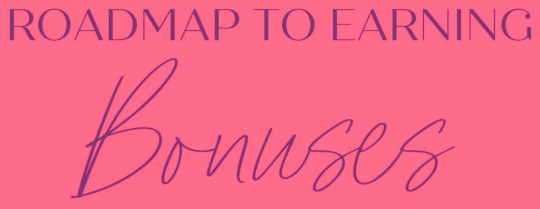
5 notes
·
View notes